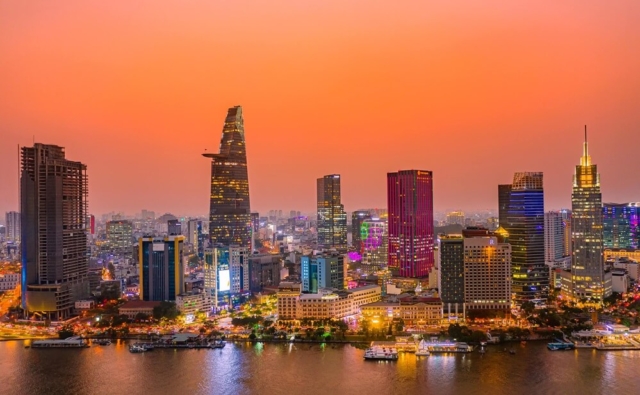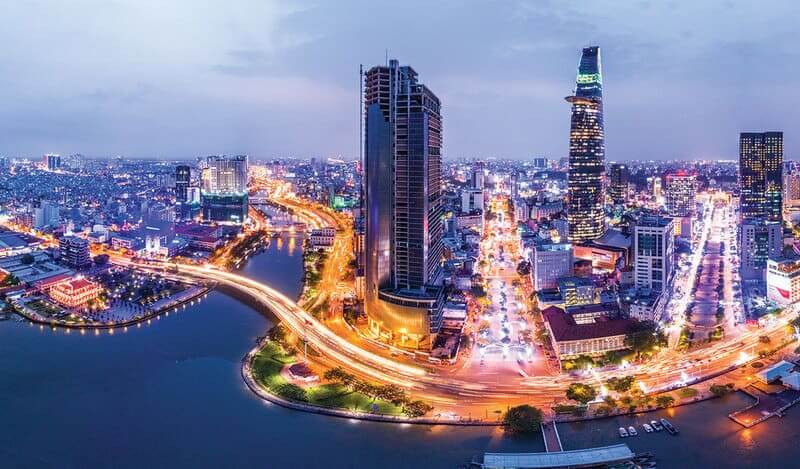An Overview of Labor Characteristics in HCMC

Aug 11, 2025
Last updated on Nov 28, 2025
In the first five months of 2025, 22,400 workers under 35 in Ho Chi Minh City were unemployed—making up 49.06% of all unemployment benefit recipients, including 9,297 university graduates. This paradox shows not only a severe skills mismatch but points to deeper employment challenges that business leaders must address when building their teams. Meanwhile, the city expects to need 800,000 to over 1 million new workers between 2025-2030, creating huge opportunities but demanding high workforce quality standards.

Key takeaways
- Ho Chi Minh City has the country’s largest workforce with 4.93 million people; it’s young and modern but surprisingly lacks enough high-quality workers.
- The market is moving quickly toward services and high-tech sectors, with nearly 1 million new workers needed by 2030, focused on AI, automation, and knowledge industries.
- Companies face very high employee turnover (according to the latest salary survey, the voluntary turnover rate can be as high as 20.3% in local enterprises) and a major gap between the skills people have and the skills companies need.
- To succeed, companies need to invest in training their own staff and work with schools to close the skills gap.
Workforce characteristics represent the core elements that define the scale, distribution, qualifications, and productivity of a region’s labor force. In HCMC, these characteristics reveal a complex yet promising landscape: Vietnam’s largest labor market with 4.93 million workers—young, dynamic, and structurally modern with a focus on services and industry—while at the same time facing high youth unemployment, constant workforce mobility, and fierce talent competition. For CEOs and business leaders, understanding these characteristics isn’t optional—it’s essential for building sustainable HR strategies as HCMC’s labor market goes through major transformation.
1. An abundant, young, and continuously growing workforce
The most notable thing about Ho Chi Minh City’s labor force is its huge size and young age.
By 2025, the city is projected to have nearly 4.93 million workers, making up roughly 9-10% of Vietnam’s total labor force. This figure not only shows the city’s position as Vietnam’s leading economic center but also reflects its powerful draw for talent from across the nation. In July 2025, HCMC will merge with Binh Duong and Ba Ria-Vung Tau, forming a megacity of nearly 14 million people, expanding the labor market with unprecedented growth potential.
The city’s biggest advantage is its large number of working-age people. Workers aged 15 and over make up 51.2% of the population, with most being between 20 and 35 years old. Each year, HCMC adds hundreds of thousands of new workers, keeping an abundant young workforce and highly competitive employment environment. The continuous flow of migrants—mainly educated young people with career ambitions, especially university and college students, technical workers, and young professionals—provides valuable reinforcement, keeping market energy and innovation strong.
The main challenge, however, is the mixed quality of the workforce. While there are highly skilled graduates from top universities and colleges, many migrant workers are unskilled. Compared to Hanoi, HCMC is larger but struggles more with having a consistent level of quality across its workforce.
2. A modern labor structure focused on services and high-tech industry
HCMC’s labor structure is steadily reducing agriculture’s share while sharply increasing workers in services and high-tech industry, aligned with Vietnam’s industrialization and modernization direction and global value chains.
1. Commerce and services (70.32% of all jobs): This is the main sector, with about 3.36 million workers. The growth of e-commerce and the digital economy has created high demand for professional roles. The top service industries for hiring are:
- Wholesale and retail: 20.77%
- Information and communications: 8.36%
- Real estate: 8.17%
2. Industry and construction (28.39% of all jobs): This is still a key sector with 1.36 million workers. Four key industries are in high demand for new talent (making up 18.6% of total need):
- Mechanics
- Pharmachemistry
- Food processing
- Electronics and IT
These industries are rapidly transitioning towards an automated manufacturing workforce model, requiring workers with advanced technical skills and the ability to operate intelligent systems.
HCMC is speeding up development in AI, data, automation, renewable energy, clean transportation, and efficient logistics—fields requiring highly qualified workers with innovative thinking and rapid adaptation abilities. Forecasts for 2025-2030 show that 70% of the 800,000 to 1 million new workers needed will be in the services-high-tech industrial cluster.
However, this transition also creates significant pressure. Unskilled workers and traditional labor-intensive sectors like textiles and footwear face replacement risk from automation. Companies must speed up retraining and career transitions for this workforce to participate in new industries, avoiding prolonged structural unemployment.
3. Labor quality is improving but deeply polarized
While the overall quality of workers has gotten better, there are still major divides in the market. HCMC’s employment challenges lie not just in quantity but in the imbalance between training quality and actual business needs.
3.1 The rate of trained labor is high but does not match demand
One of the biggest paradoxes in HCMC’s labor market is the mismatch between supply and demand in training levels. In 2025, companies need 88.11% of new hires to have some form of training. Here’s the breakdown of what they need:
- University level or higher: 18.76%
- College level: 14.6%
- Intermediate level: 20.14%
- Primary level: 34.61%
- Unskilled: only 11.89%
The problem is that while workers with university degrees are often oversupplied, most companies actually need technical workers from primary, intermediate, or college levels. This leads to a “surplus of masters, shortage of workers” problem: high unemployment for university graduates and severe shortages of skilled labor.
3.2 Skills polarization between the formal and informal sectors
About a third of the city’s workers are in the informal sector (like street vendors, ride-hailing drivers, and freelancers). While they are a big part of the economy, they have few chances for formal training, creating a two-tiered workforce with very different skill levels and opportunities.
3.3 HCMC workforce unemployment rates—Degrees no longer guarantee employment
Having a degree is no longer a sure path to employment. Among all unemployed people, 20-30% have professional training or a degree. Data from the first five months of 2025 shows that among 45,620 unemployment benefit recipients, 9,297 held university degrees or higher (20.02%), with 22,400 workers under 35 (49.06%).
The root causes of HCMC’s employment challenges come from multiple complex factors:
- On the system side, many training programs remain highly theoretical, with limited focus on practical skills and job application abilities. At the same time, the pace of updating knowledge—especially in technology and modern management—lags behind business needs. The labor market focuses on recruiting high-skilled personnel in technology and foreign languages, while untrained workers still account for nearly 40-46%.
- Among young workers, the trend of “job-hopping” to find better-fitting environments, high work pressure leading to resignation, and unclear long-term career direction are becoming common. HCMC has many large universities, attracting tens of thousands of students annually, making job competition more intense, particularly for fresh graduates.
- New disruptions from two-level government restructuring, digital transformation impacts, and post-COVID-19 business restructuring further pressure the labor market, requiring workers to continuously adapt and learn. Entry-level salaries in many sectors/units remain low with insufficient compensation; experienced personnel are difficult to retain; migrant workers lack social security, causing labor supply volatility.

4. Diverse labor distribution and income post-merger transformation
HCMC’s labor distribution landscape is going through a powerful transformation. Following the July 2025 merger with Binh Duong and Ba Ria-Vung Tau, the total workforce exceeds 5 million people. Urban workers make up roughly 66-70% region-wide; rural workers account for 30-34% in outer districts, peripheral industrial zones, and rural areas.
This distribution creates three distinct labor groups:
- Urban HCMC has dense concentration in high-tech services sectors
- Binh Duong is strong in industrial workers with developed industrial park systems
- Ba Ria-Vung Tau combines port industry, logistics services, coastal tourism labor, and agriculture
Regarding gender structure, female workers stay stable at 46.75% region-wide.
Average income shows clear polarization. In HCMC and Binh Duong’s industrial city centers, salaries range from VND 9.7-12 million/month depending on the sector—the region’s highest. Ba Ria-Vung Tau and Binh Duong districts have lower income at VND 7-9 million/month for industrial workers, while agricultural labor, fisheries, and coastal tourism services in some areas remain below VND 6 million/month.
Roughly 46.6% of the workforce belongs to the informal sector (ride-hailing drivers, delivery workers, freelancers), trending slightly upward from 2023. This presents challenges for social security and labor supply stability as the economic region expands.
5. A market of opportunities, yet always in need of top talent
Even with so many people available to work, HCMC faces a serious shortage of high-quality talent in key areas.
- For 2025 alone, the city needs 310,000-330,000 new workers, spread evenly across four quarters with demand ranging from 75,000 to 84,000 people per quarter.
- For 2025-2030, the city expects to need 800,000 to over 1 million new workers, with 70% focused on the services-high-tech industrial cluster.
The fields most in need of talent include:
- Information technology, AI, and Big Data
- Automation and digital transformation
- Finance and banking
- Efficient logistics and supply chain management
- Renewable energy and clean transportation
- E-commerce
- Modern management services
HCMC is currently recognized as Southeast Asia’s leading information technology center, with software outsourcing capabilities ranked 2nd in the region. The city has 55% of Vietnam’s total engineers and hosts major technology corporations like IBM and AWS. However, this rapid development creates a large gap between supply and demand for high-quality talent, especially as the economy shifts strongly toward digitalization, automation, and sustainable development.
The greatest challenge companies face is that training at schools hasn’t fully kept pace with market changes. Many graduates have strong theoretical knowledge but lack practical skills, teamwork abilities, and problem-solving thinking. To address this, many companies have shifted to professional recruitment services (RPO) to identify and select the most suitable candidates.
6. The most dynamic and flexible labor market
Ho Chi Minh City rightfully stands as Vietnam’s most dynamic and flexible labor market today, in terms of scale, transition speed, and ability to adapt to new workforce trends.
6.1 Continuously shifting market
The energy of HCMC’s labor market is shown by how often people change jobs, which creates both opportunities and challenges, and reflects the decisive factors of the labor market in the country’s largest economic center.
- High employee turnover: The rate of workers leaving their jobs is 18-20% per year, which is among the highest in Vietnam. In fields like textiles, it can be as high as 40-50%.
- A push for better benefits: This high turnover pushes companies to offer better pay, benefits, and work environments to keep their employees.
- The rise of the young workforce: Workers under 35 often switch jobs to find better growth opportunities, posing a recruitment challenge for the younger generation. They care about more than just salary; they want meaningful work and a good company culture, reflecting a shift in the modern workforce mindset.
- Steady job growth: The market continues to grow, with the workforce increasing by 2.1% per year and adding over 141,000 new jobs annually since 2021.
6.2 Recruitment trends: Digitalization, flexibility, and talent retention
Ho Chi Minh City’s labor market recruitment trends have changed dramatically in 2023-2025 toward modern, flexible forms with high technology use. Online job platforms and supply-demand connection platforms are growing rapidly. In the first nine months of 2025, HCMC organized 171 job fairs, consulting 329,176 person-times, combining both in-person and online formats. The trend of fast interviews with same-day results at industry recruitment events attracts large numbers of young candidates and fresh graduates, shortening recruitment time.
Companies are shifting focus from credentials to actual capabilities. Demand for workers with digital technology skills, AI, data analytics, automation, and foreign languages is surging dramatically. International Labour Organization (ILO) surveys forecast that by 2025, roughly 85 million new jobs globally will be created through digital technology and automation, while 60% of businesses seek personnel with AI, Big Data, and cybersecurity skills. HCMC leads this trend in Vietnam.
6.3 Benefits policies become decisive factors
With 18-20% annual labor mobility, companies must invest seriously in employee benefits policies and work environment improvements. Competitive benefits packages include not only compensation but also mental health focus, remote work flexibility, career development opportunities, and inclusive, diverse corporate culture.
During the peak holiday and Tet 2026 period, seasonal labor recruitment demand in HCMC surges strongly, particularly in trade-services, F&B, retail, logistics, and manufacturing sectors. Forecasts show the pre-Tet job market will need an additional 25,000-30,000 short-term positions, mainly meeting export orders, surging consumer demand, and year-end promotional events. Flexible contract models and part-time work continue rapid development, serving both seasonal businesses and aligning with young workers’, students’, and multi-job workers’ preferences for short-term and independent work.
An overview of labor characteristics in HCMC shows a market in a critical transition phase, embodying both great opportunities and significant challenges. Correctly grasping these characteristics will determine the success of a company’s HR strategy and its competitive edge in the future. Companies need solid market data foundations to shape competitive compensation policies, optimize recruitment processes, and build clear talent development roadmaps. From comprehensive HR strategic consulting to flexible staffing solutions and recruitment process optimization—these tools help companies rapidly bridge the gap between demand and supply, transforming the megacity’s massive labor market into sustainable competitive advantage for 2026 and beyond.

Solve your HR problems!
6th Floor, Star Building, 33 Mac Dinh Chi, Saigon Ward, Ho Chi Minh city, Vietnam





